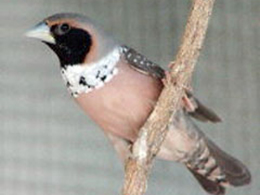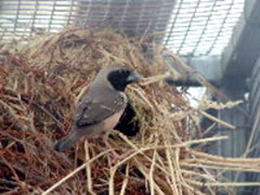Pictorella Munia. Photo: Mark Helle
Article kindly provided by Doug Hill & Marcus Pollard
Availability
The Pictorella Munia (Lonchura pectoris) has become uncommon in Australian aviaries with mainly specialist breeders now holding them. The status of the Pictorella in the wild is classified as Near Threatened.
Sexing
The breast bar of the male and female is covered with white spots, with the male being a more mottled white with the spots running into each other and forming lines whereas the hen has more distinct spotting on the chest. The black facial mask of this bird is darker on the male than it is on the female. It is not difficult to distinguish between the male and female Pictorella.
Mutations
I have not heard of any type of mutation at all in the Pictorella.
Distribution
Northern Australia from Northern Queensland and across the top end of Australia throughout the Kimberley region and into the northern coast of Western Australia as far as Derby.
Compatibility
An absolutely peaceful bird to have in any mixed collections of finches. They keep to themselves and tend to become quiet friendly towards the person who does the daily chores around their aviary.
Ease of breeding (1 easy-10 difficult)
8/10 - Despite this rating whenever I have kept Pictorella’s I have had no problems with them going to nest for me. But then I am prepared to feed rather a lot of live food! Mind you getting them to go to nest and actually rear chicks can sometime be two different propositions! In many cases I suspect this may have been overcome by supplying them with plenty of coarse green grass – such as from some of the Poa-type tussock grass. I have had people tell me that they have given up on them, as they cannot get them to even look at a nesting site. If you can supply plenty of live food 2-3 times a day you should achieve success with these birds. However, I feel I must preface this with a warning that some pairs may often throw their chicks out despite the presence of large amounts of live food. I had one pair that threw 32 chicks out at varying stages of development – from day olds to almost fledged – despite there being enough live food to breed a number of Grenadier weavers with!! The happy ending was that they eventually deigned to rear 12 youngsters!
Purchasing your bird
It would be difficult to find the Pictorella at bird outlets these days. To find the Pictorella you would most likely have to get in touch with your local Finch Society or Avicultural Society. They can be found by asking at your local bird outlet or pet shop, or by looking through one of the major avicultural magazines.
Good points to look for
Look for birds in good feather. The amount of spots on the chest area. The richness of the black on the cock bird. Clean vent. Size of the bird. Clear bright eyes. A bird that is always on the move. Being a bird that spends large periods of time on the ground you must take great care when selecting your birds.
Faults to look for
Birds that are lethargic. Fluffed up with closed eyes. Soiled ventral area. Poor feather and poor colouring. Lack of cleanliness of the beak and legs.
Aviary or breeding cabinet
Pictorellas do not do so well in cabinets, very small aviaries or suspended aviaries. On occasions I have had to bring birds inside when they were feeding young due to illness to one of the parents. In all cases the healthy parent successfully reared the youngsters and crop feeding was not required but they always remained ill at ease in a small cage. Pictorellas will do well in aviaries from about 3m on and will do much better in larger well-planted aviaries. The only draw back in large planted aviaries is that they will spend long periods on the ground and you must ensure that you keep the floor dry and worm your birds regularly. Pictorellas can be kept as a colony or in single pairs.
“ I have had people tell me that they have given up on them, as they cannot get them to even look at a nesting site. If you can supply plenty of live food 2-3 times a day you should achieve success with these birds. ”
Breeding season
The breeding season for the Pictorella begins at the start of spring and goes throughout the warmer months and tends to ease off during the colder months. It is better not to breed the Pictorella during the colder months, as the young tend to live on the floor of the aviary for a week or so after they have fledged from the nest. During this time they are susceptible to the cold and could easily expire. Also, don’t forget that the Pictorella does not line its nest so the young may suffer if you try breeding during inclement months.
Off-season feeding
An austerity diet of dry mixed seeds, grits, cuttlebone and eggshells is supposedly efficient. A fresh supply of some seeding grasses is also recommended on occasions.
Should I feed soft foods?
If you do have a good mix of egg and biscuit formula it can be fed to the birds on a daily basis. Generally "Picts’ show little interest in many soft food lines so it may be necessary to introduce these via their soaked seed dish!
What green feed?
Fresh grass seed can be fed daily in the breeding season. Other green feed can consist of cucumber, spinach, chickweed, endive and boc-choy. You can expect better breeding results if fresh seeding grasses are fed during the breeding season.
What live food?
Pictorellas thrive when supplied with copious amounts of termites, gentles (maggots) and mealworms. One breeder achieved success by feeding his Pictorellas on mosquito ‘wrigglers’! Although live food is not fully necessary outside of the breeding season it is an integral part of their breeding regime. Most of the successful breeders spoken to stated that a diverse live food ‘menu’ was essential for rearing this species. A word of warning if intending to fed large amounts of crickets. I once placed around 300 in a large garbage bin with a dowel perch running down into it for ease of entry and noticed the Picts were the first birds into the bin. About 30 minutes later they were still in the garbage bin systematically slaughtering every mealworm in the bin! After the ‘job’ was complete they selected one each and flew to a nearby perch to consume their meal. Only problem was how many birds are going to eat a bin of dead crickets – an expensive exercise at the time!
“The breeding season for the Pictorella begins at the start of spring and goes throughout the warmer months and tends to ease off during the colder months.”
Breeding season feeding
When the weather starts to warm after the chills of winter is usually the time to start your breeding program. This is when you start to slowly give your birds some extra bits in their feed tray. Let the birds build up to the extra live food such as termites, mealworms, gentles and green seeding grasses. Too much too soon can easily cause all types of problems including scours. Some of the seeding grasses that may be used are, Johnston grass, African Veldt grass, chickweed, Winter grass, Guinea grass, Milk thistle, Green Panic and Shepherds Purse. All the while still supplying them with their usual greens such as Endive, Kale, Bok-choy and Lebanese cucumber
What age do they breed?
They are ready to breed at 9 months. Males will also fill eggs when not fully coloured.
What if I lose a mate?
Although pair bonding is strong, if one loses a mate, immediately introduce another mate. It sometimes may take a while for a surviving partner to accept a new mate, but it is not always the case of any new partner being accepted at all. I have a friend who had a male on his own for 3 years before finally accepting a new partner.
Nesting receptacles
I have never had Pictorellas nest in any type of nesting basket or nest box. They will use tea-tree filled wire cylinders or simply construct their nest in the brush of the aviary. Their favourite spot is usually half way up a clump of growing grass and have seen several nesting in such a manner in Pennesetum grasses. If the grass is old and thick enough the birds nest will remain dry but have also seen a bird die from pneumonia after the nest was soaked. Basically beware of them nesting in such a manner and be prepared to erect some sort of cover lest you lose the lot!
Nesting materials
Nesting materials can vary from November grasses for the nest lining and coarser grasses for the exterior. Plenty of nesting material should be offered for them to pick over. I have not had Pictorellas use feathers to line a nest. A coarse tussock grass is favoured for the bulk of the external nest covering.
The nest
The Pictorellas build a nest about 150cm in diameter. It is a loosely built dome type structure and built anywhere from the floor to 2m from the floor. The nest is not a tidy type of nest like the Star finch, but an untidier framework structure with an entrance hole in the side. Coarser tussock type grasses are often preferred for the outer shell while there is, normally, no feather lining inside the nest.
Mating behaviour
The courtship ritual with the Pictorella is something else to see. I have never seen a Pictorella courtship take place anywhere but on the ground. Both the male and female pick at the floor of the aviary and then start picking up items from the ground only to drop them almost immediately. The male then with a piece of grass or some type of token in his beak facing skywards fluffs out his feathers and begins his dance. He fans his tail feathers out and dragging them on the ground he commences to dance in front of the hen. His dancing will take him from side to side of the hen or in complete circles around her. He will side up to the hen, who, when ready to mate will begin to quiver her tail. Copulation takes place almost immediately. The whole thing is over very quickly.
Eggs
Between 4 and 6 white eggs are laid. NO PEEKING AND NO FINGERS. DO NOT TOUCH THE NEST. If you touch the nest they will almost certainly desert the nest. Nests of 7 and 8 have been witnessed by the authors!
Brooding time
It generally takes 13/14 days to incubate the eggs with the hen doing the majority of the sitting. The male has stints at sitting during the daylight hours. It is the hen that sits the eggs at night.
Fledging time
Fledging usually takes around 21 days. It may take a bit longer during the colder months so allow for that extra day or so before poking fingers into the nest. Be aware that if you poke your finger into the nest and the young are not too far off fledging you are going to have young Pictorella’s jumping out of the nest at a rate of knots and they are VERY hard to get back in there again!!
Independence from the Parents
Independence is around 21 days. I always allow at least 28 days before deciding that any young are independent from the parents just to be on the safe side. Beware that youngsters do not have the quiet nature of their parents and, if kept in small flights, their antics often upset the other inhabitants even to the extent of disrupting their breeding.
How long do the young stay with the parents?
It is best to leave the young with the parents for at least 4 weeks. The young may be left with the parents without any interference from them during other broods. However, in some instances the young may attempt to return to the new nest at night which may upset the parents or cause harm to the new chicks - guess this can also depend upon the size of your aviary where there might be more room to spread out in larger flights.
“This shy and sometimes elusive bird is a delight for any mixed aviary of finches. They are never a bother to the other inhabitants of the aviary mainly keeping to themselves. However, in order to do the birds justice, you should consider their live food needs before acquiring them for your collection.”
What do I feed the fledged young?
The young birds can be given the same diet as the parents.
When do I ring the young?
The young can be rung immediately after they have left the nest. If you leave it too long the ring will not slip over the toes. When ringing young birds after they have left the nest be careful not to damage the toes if intending to close ring your birds.
Separating the pairs
I have found that at times some pairs of Pictorella’s do tend to over bred. As they can have up to 6 young at a time it is important to keep an eye on the birds to ensure that the hen does not breed herself out by raising too many broods. It is far better practice to rest the hen than trying for that ‘extra few young ‘uns’ – dead hens wont breed!
Showing your bird
Pictorella’s do not make an ideal show bird because of their shy nature. However, if you do decide to show your birds then judges will look for birds in good feather with clean mandibles, legs and feet. The birds must be bright of eye, alert and moving from perch to perch in the show cage. The spots on the chest area must be clear and white. The facial mask must be an even and glossy black.
Gene pool
We have a very good gene pool of Pictorella’s in Australian aviaries probably due to them not having any type of mutation to detract from the pure type bird. I feel that the future of the Pictorella is very secure but we need to ensure that good captive stocks are maintained to prevent another severe decline in numbers as experienced during the late 1990’s.
Common ailments
Pictorella’s need a good worming program as they are forever picking around the floor of the aviary. A good worming program is needed for them. Also as they are mainly a ground dwelling bird a treatment for coccidiosis should be administered – especially following periods of wet weather.
Summary
This shy and sometimes elusive bird is a delight for any mixed aviary of finches. They are never a bother to the other inhabitants of the aviary mainly keeping to themselves. However, in order to do the birds justice, you should consider their live food needs before acquiring them for your collection. Their live food requirements often make them the ‘next level’ of difficulty when considering which finch to add to their collection. Don’t fret, once you’ve mastered the Pictorella there is always the Red-wing Pytilia to move up to on the next level.






